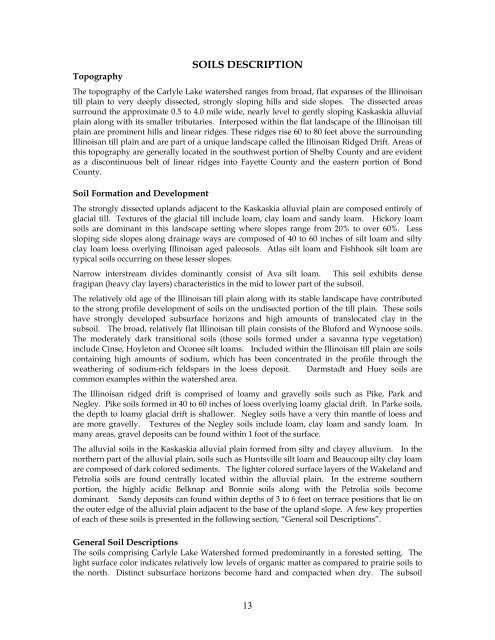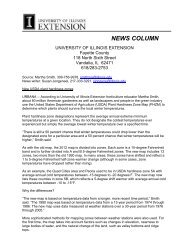Carlyle Lake Final Plan.pdf - Fayette County Soil & Water ...
Carlyle Lake Final Plan.pdf - Fayette County Soil & Water ...
Carlyle Lake Final Plan.pdf - Fayette County Soil & Water ...
Create successful ePaper yourself
Turn your PDF publications into a flip-book with our unique Google optimized e-Paper software.
Topography<br />
SOILS DESCRIPTION<br />
The topography of the <strong>Carlyle</strong> <strong>Lake</strong> watershed ranges from broad, flat expanses of the Illinoisan<br />
till plain to very deeply dissected, strongly sloping hills and side slopes. The dissected areas<br />
surround the approximate 0.5 to 4.0 mile wide, nearly level to gently sloping Kaskaskia alluvial<br />
plain along with its smaller tributaries. Interposed within the flat landscape of the Illinoisan till<br />
plain are prominent hills and linear ridges. These ridges rise 60 to 80 feet above the surrounding<br />
Illinoisan till plain and are part of a unique landscape called the Illinoisan Ridged Drift. Areas of<br />
this topography are generally located in the southwest portion of Shelby <strong>County</strong> and are evident<br />
as a discontinuous belt of linear ridges into <strong>Fayette</strong> <strong>County</strong> and the eastern portion of Bond<br />
<strong>County</strong>.<br />
<strong>Soil</strong> Formation and Development<br />
The strongly dissected uplands adjacent to the Kaskaskia alluvial plain are composed entirely of<br />
glacial till. Textures of the glacial till include loam, clay loam and sandy loam. Hickory loam<br />
soils are dominant in this landscape setting where slopes range from 20% to over 60%. Less<br />
sloping side slopes along drainage ways are composed of 40 to 60 inches of silt loam and silty<br />
clay loam loess overlying Illinoisan aged paleosols. Atlas silt loam and Fishhook silt loam are<br />
typical soils occurring on these lesser slopes.<br />
Narrow interstream divides dominantly consist of Ava silt loam. This soil exhibits dense<br />
fragipan (heavy clay layers) characteristics in the mid to lower part of the subsoil.<br />
The relatively old age of the Illinoisan till plain along with its stable landscape have contributed<br />
to the strong profile development of soils on the undisected portion of the till plain. These soils<br />
have strongly developed subsurface horizons and high amounts of translocated clay in the<br />
subsoil. The broad, relatively flat Illinoisan till plain consists of the Bluford and Wynoose soils.<br />
The moderately dark transitional soils (those soils formed under a savanna type vegetation)<br />
include Cinse, Hoyleton and Oconee silt loams. Included within the Illinoisan till plain are soils<br />
containing high amounts of sodium, which has been concentrated in the profile through the<br />
weathering of sodium-rich feldspars in the loess deposit. Darmstadt and Huey soils are<br />
common examples within the watershed area.<br />
The Illinoisan ridged drift is comprised of loamy and gravelly soils such as Pike, Park and<br />
Negley. Pike soils formed in 40 to 60 inches of loess overlying loamy glacial drift. In Parke soils,<br />
the depth to loamy glacial drift is shallower. Negley soils have a very thin mantle of loess and<br />
are more gravelly. Textures of the Negley soils include loam, clay loam and sandy loam. In<br />
many areas, gravel deposits can be found within 1 foot of the surface.<br />
The alluvial soils in the Kaskaskia alluvial plain formed from silty and clayey alluvium. In the<br />
northern part of the alluvial plain, soils such as Huntsville silt loam and Beaucoup silty clay loam<br />
are composed of dark colored sediments. The lighter colored surface layers of the Wakeland and<br />
Petrolia soils are found centrally located within the alluvial plain. In the extreme southern<br />
portion, the highly acidic Belknap and Bonnie soils along with the Petrolia soils become<br />
dominant. Sandy deposits can found within depths of 3 to 6 feet on terrace positions that lie on<br />
the outer edge of the alluvial plain adjacent to the base of the upland slope. A few key properties<br />
of each of these soils is presented in the following section, “General soil Descriptions”.<br />
General <strong>Soil</strong> Descriptions<br />
The soils comprising <strong>Carlyle</strong> <strong>Lake</strong> <strong>Water</strong>shed formed predominantly in a forested setting. The<br />
light surface color indicates relatively low levels of organic matter as compared to prairie soils to<br />
the north. Distinct subsurface horizons become hard and compacted when dry. The subsoil<br />
13



